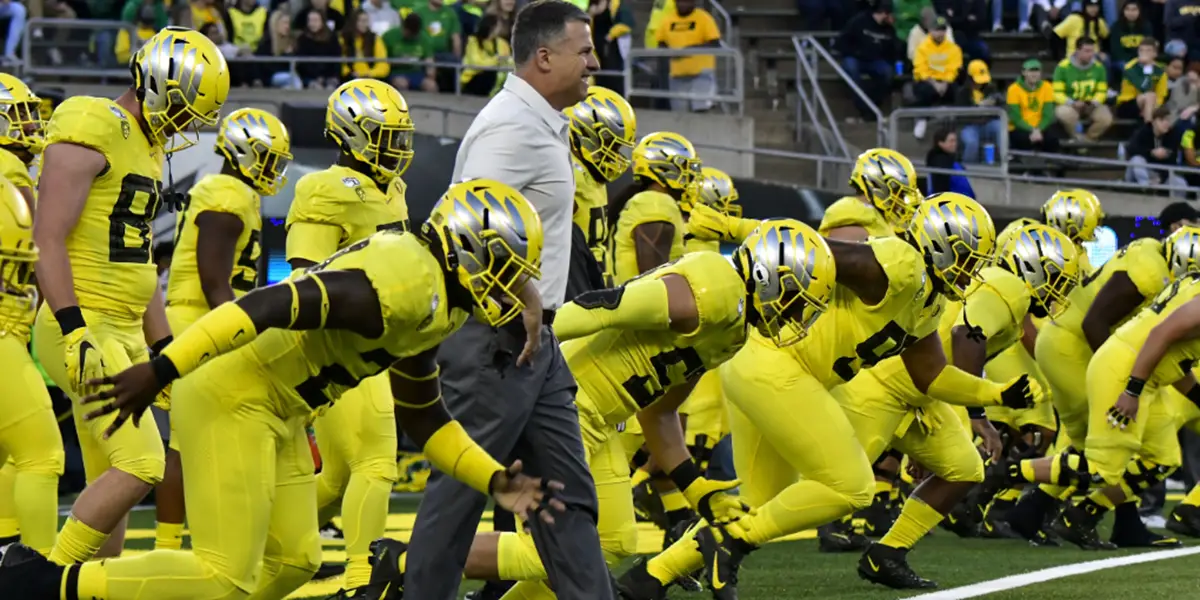In today’s era of high-scoring, fast-paced offensive football, the last thing fans want to see is an offense that turns back the clock with slow, unexciting power football. When Oregon head coach Mario Cristobal announced that the Ducks’ offense would be centered around a physical, downhill rushing offense, the Oregon faithful went into a frenzy. Fans feared the worst, expecting Oregon’s offense to regress to the stone age of offensive football.
While those concerns were slightly overblown, fans certainly had a right to be somewhat skeptical of Cristobal’s approach. Even the most steadfast football traditionalists have conceded that spreading the field and getting playmakers in space, primarily through the air, is an effective strategy. Running the ball up the gut and pounding opponents into submission is no longer believed to be smartest way to build an offense.
But there are elements of the “smashmouth” offense that can still be effective, even in today’s day and age.
While a coach doesn’t do his team any favors by running the ball into crowded piles, hoping to gain some sort of physical advantage by mindlessly “establishing the run,” the thought process of using an efficient, between-the-tackles running game to move the ball makes sense. The smashmouth offense can work, but it has to be tweaked to succeed.
Why Traditional Smashmouth Offenses Won’t Work
Prototypical smashmouth offenses have big, road-grading linemen, powerful tailbacks, monster tight ends and even multiple fullbacks. They typically run 12 or 21 personnel — that is, formations with one running back and two tight ends or formations with two running backs and one tight end — and sometimes they’ll even bring in an extra offensive lineman.

Stanford is known for its physical, run-blocking offensive lines.
Teams that run the smashmouth offense have one priority, and that’s to establish the run, largely by overpowering their opponent. When they go to the air, they’ll utilize play action. But everything starts with a run-heavy, downhill approach and jumbo personnel groupings. College football teams that have recently run, or continue to run, smashmouth offenses include Stanford, Michigan, Michigan State, Alabama (prior to Lane Kiffin’s arrival) and LSU (during Les Miles’ time as head coach there).
Very few smashmouth offenses have actually been statistically efficient. Teams have had their share of success with downhill, power rushing offenses, but typically because they had dominant defenses to back them up. These teams could have run just about any offensive scheme and had a level of success because of how effective their defenses were, and in fact, they likely would have been more successful had they used better offensive systems.
The reason why smashmouth offenses generally struggle is because they depend on very inefficient strategies to be successful. In the most basic terms, a successful offense scores a lot of points, and the easiest way to score points is to move the ball well on a per-play basis. It’s pretty simple: the more yards per play that an offense gets, the more likely it’s driving within scoring range consistently.
If the goal of an offense is solely to gain as many yards as possible on a per-play basis, its best bet is to pass the ball. Even the most ineffective passing offenses average more yards per play than the best rushing offenses, and therefore, they’re more likely to move the ball towards the endzone.

LSU and Joe Burrow showed just how effective passing the ball can be in 2019.
This is the first issue with the smashmouth offense; it’s a ground-based attack. The offense uses the passing game to complement the running game, rather than the other way around, so more often, the offense is calling plays that gain less yards by default. The thought process behind this philosophy is to set up the play action pass by establishing the run, but studies have shown that play action passes are successful regardless of how much a team runs the ball. Still, many other schemes are ground-based and happen to be largely successful (there are benefits to running the ball, as getting as many yards as possible is not the only function of an offense), so the fact that the smashmouth offense is run heavy isn’t the only problem with the system.
The box count (how many defenders are within the tackle box and close to the line of scrimmage) is perhaps the biggest determinant of rushing-game success. Although run blocking and running backs also impact the result of running plays, the majority of teams that run the ball well do so by creating numbers advantages, in addition to having skilled blockers and tailbacks. There are many ways to achieve this advantage (spreading the defense out and using some sort of option system is probably the most commonly adopted method); doing so makes life far easier for the offense.
But one way to completely nullify any potential numbers advantage is to bring in multiple tight ends or a fullback and compress the offense. That invites the defense to load the box and it makes running the ball successfully completely dependent on the skill of the blockers and the runner. Sometimes, a team will still find success in these circumstances simply because it has really good blockers and runners, but continuing to rely on that skill over time is a gamble, especially when there’s a better alternative.
Here’s How the Smashmouth Offense Can Be Effective
There is logic behind trying to build a team around a straightforward, simplistic rushing offense, specifically in college.

Every coach wants a dominant rushing attack.
Passing the ball produces more yards than running the ball, but its success is disproportionately influenced by one player (the quarterback). That position happens to be one of the most difficult to scout, develop and keep healthy, so college coaches often steer clear of centering their offenses around one, as a passing offense becomes far riskier and less effective without a capable one.
It’s way easier to install a basic rushing offense and recruit big, physical linemen than it is to find blue-chip quarterbacks and perfect an elaborate passing scheme, especially with increasingly limited practice time. So, the run-first approach of many collegiate teams makes sense. It’s also understandable why some coaches don’t want to add a bunch of reads and wrinkles to their running games, as the wrong read could lead to a loss of yards at best and a turnover or potential injury to their quarterback at worst.
But teams don’t run the ball efficiently by running into crowded boxes, no matter how big and talented their blockers are. The fact of the matter is, if a team is going to be centered around a downhill rushing offense, it has to lighten the box count to be successful.

One way or another, offenses have to gain a numbers advantage to run the ball successfully.
As long as parameters are put in place to consistently achieve numbers advantages, running the ball up the middle with a big, bruising offensive line and a running back with a full head of steam is one of the best ways to move the ball. Ohio State and Clemson, for example, did this amazingly well in 2019. But both teams did so from the spread, utilizing perimeter screens, play-action shots, run-pass options and read options in tandem with their inside zone running plays. All of these elements lightened the box, which made their between-the-tackles rushing attack even deadlier.
Cristobal isn’t crazy for wanting to be physical and to get easy yards up the middle as often as possible. It’s a good strategy that can make life easy on a quarterback and play caller if done successfully. But in order for that strategy to work, the Ducks have to make an emphasis on dictating the box count, which means spreading the field rather than compressing it. Teams have been running this “smashmouth spread” offense for a few years now, and it’s the best way to take the inherent advantages of the spread offense and combine them with a power running game.
For teams and coaches that routinely recruit and develop offensive linemen significantly better than anyone else in the country, the smashmouth spread offense is a great system. For these teams, it’s a risk-averse, efficient way of consistently gaining positive yards against overmatched front sevens.
As long as Cristobal continues to implement elements that lighten the box and punish defenders for loading up to stop the run, his dream of pounding defenses into submission will come to fruition.
Joshua Whitted
Morgantown, West VirginiaTop Photo by Eugene Johnson
Joshua is an adopted Duck fanatic, originally hailing from southwestern Pennsylvania. His love for the University of Oregon began as a young child when he became mesmerized by the flashy uniforms and explosive offenses of the Chip Kelly era, and now, he follows the team religiously. His fondest memory of the team is seeing De’Anthony Thomas race past Wisconsin defenders back in the 2012 Rose Bowl. A true football enthusiast, Joshua loves studying the intricacies of the game, and he aspires to become a professional sports journalist. Joshua now resides in Morgantown, West Virginia where he works in customer service. When he’s not watching Oregon replays, Joshua loves reading, writing, and spending time with his family. Contact: whittedjd@gmail.com


